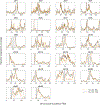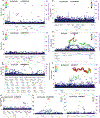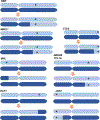Chromosomal alterations among age-related haematopoietic clones in Japan
- PMID: 32581364
- PMCID: PMC7489641
- DOI: 10.1038/s41586-020-2426-2
Chromosomal alterations among age-related haematopoietic clones in Japan
Abstract
The extent to which the biology of oncogenesis and ageing are shaped by factors that distinguish human populations is unknown. Haematopoietic clones with acquired mutations become common with advancing age and can lead to blood cancers1-10. Here we describe shared and population-specific patterns of genomic mutations and clonal selection in haematopoietic cells on the basis of 33,250 autosomal mosaic chromosomal alterations that we detected in 179,417 Japanese participants in the BioBank Japan cohort and compared with analogous data from the UK Biobank. In this long-lived Japanese population, mosaic chromosomal alterations were detected in more than 35.0% (s.e.m., 1.4%) of individuals older than 90 years, which suggests that such clones trend towards inevitability with advancing age. Japanese and European individuals exhibited key differences in the genomic locations of mutations in their respective haematopoietic clones; these differences predicted the relative rates of chronic lymphocytic leukaemia (which is more common among European individuals) and T cell leukaemia (which is more common among Japanese individuals) in these populations. Three different mutational precursors of chronic lymphocytic leukaemia (including trisomy 12, loss of chromosomes 13q and 13q, and copy-neutral loss of heterozygosity) were between two and six times less common among Japanese individuals, which suggests that the Japanese and European populations differ in selective pressures on clones long before the development of clinically apparent chronic lymphocytic leukaemia. Japanese and British populations also exhibited very different rates of clones that arose from B and T cell lineages, which predicted the relative rates of B and T cell cancers in these populations. We identified six previously undescribed loci at which inherited variants predispose to mosaic chromosomal alterations that duplicate or remove the inherited risk alleles, including large-effect rare variants at NBN, MRE11 and CTU2 (odds ratio, 28-91). We suggest that selective pressures on clones are modulated by factors that are specific to human populations. Further genomic characterization of clonal selection and cancer in populations from around the world is therefore warranted.
Conflict of interest statement
No competing interests exist in this paper.
Figures










Similar articles
-
Monogenic and polygenic inheritance become instruments for clonal selection.Nature. 2020 Aug;584(7819):136-141. doi: 10.1038/s41586-020-2430-6. Epub 2020 Jun 24. Nature. 2020. PMID: 32581363 Free PMC article.
-
Insights into clonal haematopoiesis from 8,342 mosaic chromosomal alterations.Nature. 2018 Jul;559(7714):350-355. doi: 10.1038/s41586-018-0321-x. Epub 2018 Jul 11. Nature. 2018. PMID: 29995854 Free PMC article.
-
Clonal dynamics after allogeneic haematopoietic cell transplantation.Nature. 2024 Nov;635(8040):926-934. doi: 10.1038/s41586-024-08128-y. Epub 2024 Oct 30. Nature. 2024. PMID: 39478227 Free PMC article.
-
Risk factors for clonal hematopoiesis of indeterminate potential and mosaic chromosomal alterations.Transl Res. 2023 May;255:171-180. doi: 10.1016/j.trsl.2022.11.009. Epub 2022 Nov 20. Transl Res. 2023. PMID: 36414227 Free PMC article. Review.
-
Clonal hematopoiesis in hematological disorders: Three different scenarios.Exp Hematol. 2020 Mar;83:57-65. doi: 10.1016/j.exphem.2020.01.013. Epub 2020 Jan 30. Exp Hematol. 2020. PMID: 32007480 Review.
Cited by
-
Association of Mosaic Chromosomal Alterations and Genetic Factors with the Risk of Cirrhosis.J Clin Transl Hepatol. 2024 Jun 28;12(6):562-570. doi: 10.14218/JCTH.2023.00575. Epub 2024 May 28. J Clin Transl Hepatol. 2024. PMID: 38974956 Free PMC article.
-
Age-related loss of chromosome Y is associated with levels of sex hormone binding globulin and clonal hematopoiesis defined by TET2, TP53, and CBL mutations.Sci Adv. 2023 Apr 21;9(16):eade9746. doi: 10.1126/sciadv.ade9746. Epub 2023 Apr 21. Sci Adv. 2023. PMID: 37083525 Free PMC article.
-
Nature or Nurture? Role of the Bone Marrow Microenvironment in the Genesis and Maintenance of Myelodysplastic Syndromes.Cancers (Basel). 2021 Aug 16;13(16):4116. doi: 10.3390/cancers13164116. Cancers (Basel). 2021. PMID: 34439269 Free PMC article. Review.
-
Hematopoietic mosaic chromosomal alterations increase the risk for diverse types of infection.Nat Med. 2021 Jun;27(6):1012-1024. doi: 10.1038/s41591-021-01371-0. Epub 2021 Jun 7. Nat Med. 2021. PMID: 34099924 Free PMC article.
-
Genomic Aging, Clonal Hematopoiesis, and Cardiovascular Disease.Arterioscler Thromb Vasc Biol. 2023 Jan;43(1):3-14. doi: 10.1161/ATVBAHA.122.318181. Epub 2022 Nov 10. Arterioscler Thromb Vasc Biol. 2023. PMID: 36353993 Free PMC article. Review.
References
Publication types
MeSH terms
Grants and funding
LinkOut - more resources
Full Text Sources
Other Literature Sources
Medical
Research Materials
Miscellaneous

